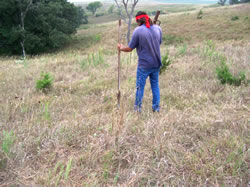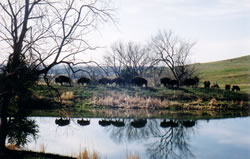
National Fire Plan Success Story
Fire Monitoring Plots Help Improve Ponca Buffalo Pasture
Nebraska
National Fire Plan - Fuels Monitoring
2010

Larry Wright places first monitoring plot. Photo by Morgan Beverage, BIA Fire Management Officer, Great Plains Region.

Ponca buffalo herd in pasture. Photo by Larry Write, Ponca tribe of Nebraska Buffalo Manager.
Larry Wright the Ponca tribe of Nebraska Bison Program Manager was first hired in 1996 to restore and manage the Nebraska Ponca bison herd, then 65 head. After many hours of observation, Wright believed the herd was suffering because the native grass the bison historically foraged on was being lost to invasive species. Wright began to work with the Tribe’s Environmental Protection Department, BIA fire management specialists, and other federal programs to develop a means of enhancing forage quality and availability. The result was the development of an aggressive fire management plan.
Thanks to an interagency collaboration between the Tribe, Natural Resources Conservation Service, BIA and several other agencies, the Poncas are successfully restoring native grasslands and in turn, improving and increasing their bison herd, the lifeblood of their culture. Using fire, herbicides and other mechanical treatments, the pasture is slowly starting to regain its vitality.
To meet the Tribe’s goal of improving vegetation palatability for the bison, the tribe wants to improve health and vigor to three focus species: Big Bluestem, Little Bluestem and Western Wheatgrass. The tribe would also like to reduce invasive species such as Smooth Brome and Bull Thistle. In 2005, Wright installed the first five vegetation inventory plots, followed in 2006 by 10 additional FIREMON monitoring plots installed by the Student Conservation Association. The first 160-acre planned ignition took place in 2006 and two years after the ignition, monitoring results were collected to assess the effects of the treatment.
Post fire monitoring data shows the three focus species increased productivity; however, the occurrence of Smooth Brome and Bull Thistle also increased. Managers are planning another prescribed fire as a follow-up treatment in the spring of 2010 to improve regeneration of desired species. To eliminate the invasive species, a combination of seeding and herbicide applications will also occur.
The use of prescribed fire and fire effects monitoring plots will continue as management tools. The plots serve to ensure the treatments are meeting tribal objectives and/ or if additional measures may be necessary.
Wright is pleased with the success of the treatments thus far. He reports the bison herd is now over 100 head, which is the current carrying capacity of the pasture.